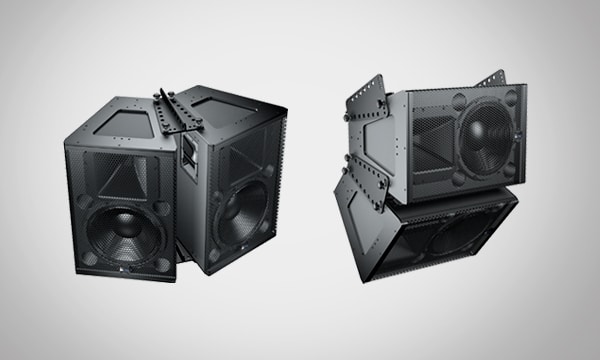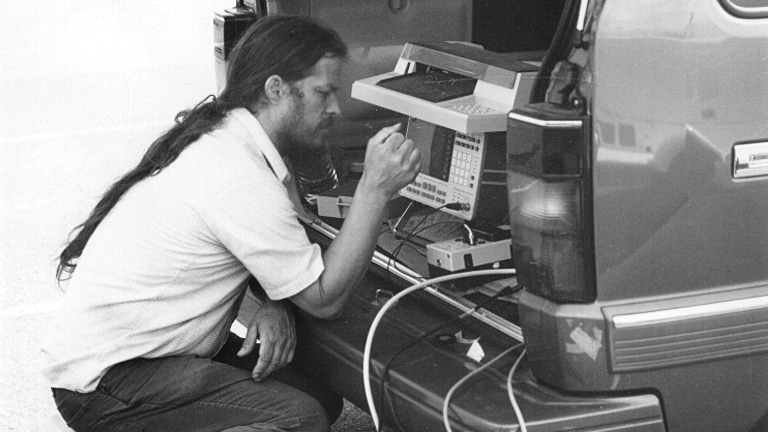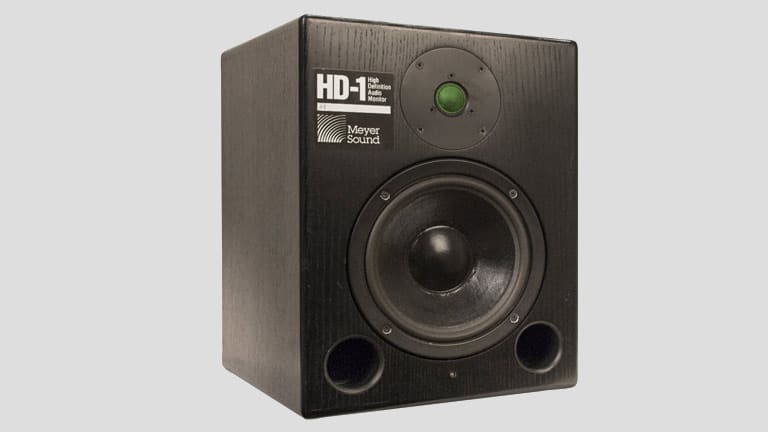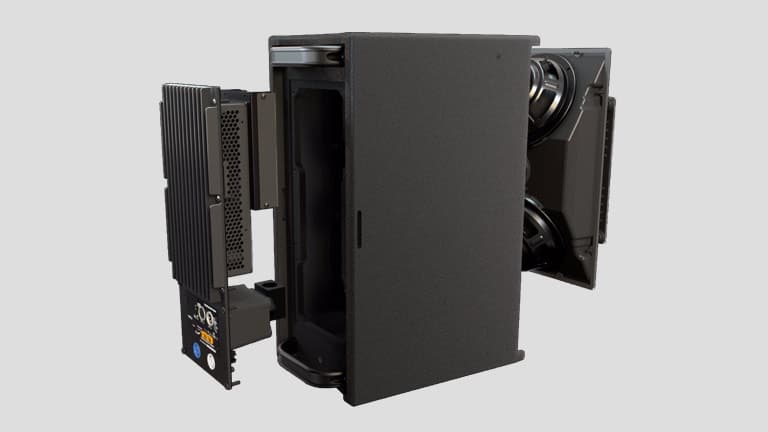| Part Number | 40.185.054.01 |
| Self-Weight | 7 lbs / 3.18 kg |

Meyer Sound’s award-winning UPQ loudspeakers have been core components in both portable and installed systems for more than a decade. Characterized by a high power-to-size ratio; smooth, uniform coverage; and consistent polar response; these two-way, self-powered loudspeakers are available in three coverage patterns to fit any application, from FOH mains in small-to-midscale systems to fills in large systems.
Predictable performance is key to accurate system design. The UPQ family’s signature Constant Q horn design delivers a consistent beamwidth across a wide frequency range, with gentle, uniform roll-off outside its defined coverage area and ultra-flat amplitude and phase response for tonal accuracy and precise imaging.
We've brought the technology from our flagship line arrays to these stalwarts of our loudspeaker offerings which are now lighter weight and powered by an all-new built-in 2-channel Class D amplifier with reduced current draw. Count on UPQ loudspeakers to deliver high output with low distortion, thanks to sophisticated DSP that includes limiters, correction filters, phase-corrected processing, and driver-protection circuitry.

UPQ loudspeakers are smooth operators in the field, packed with practical features like Meyer Sound’s Intelligent AC power supply, which adapts to any voltage worldwide and provides soft-turn on and transient protection; and optional RMS monitoring that lets you keep an eye on system stats from a remote PC.
Tour-tough enclosures are equipped with convenient attachment points and are compatible with Quickfly rigging options for fast deployment. Weather protection and custom color finishes are also available.
UPQ-D1: Wide CoverageThe UPQ-D1’s wide, symmetrical 80° horizontal x 50° vertical pattern provides uniform coverage over a broad listening area. | UPQ-D2: Narrow CoverageThe UPQ-D2 features a tightly focused 50° x 50° pattern for the most precise coverage and arrayability, minimizing interaction with walls and nearby speakers. | UPQ-D3: Ultra-Wide CoverageThe UPQ-D3 is the latest addition to the UPQ family offers the widest horizontal and vertical coverage in the series, with an 80° x 80° pattern. |
UPQ-D1: Wide CoverageThe UPQ-D1’s wide, symmetrical 80° horizontal x 50° vertical pattern provides uniform coverage over a broad listening area. | |
UPQ-D2: Narrow CoverageThe UPQ-D2 features a tightly focused 50° x 50° pattern for the most precise coverage and arrayability, minimizing interaction with walls and nearby speakers. | |
UPQ-D3: Ultra-Wide CoverageThe UPQ-D3 is the latest addition to the UPQ family offers the widest horizontal and vertical coverage in the series, with an 80° x 80° pattern. |
Meyer Sound has been pioneering self-powered loudspeakers for professional installations and touring since 1995. We’ve committed to self-powered systems because we know they deliver unrivaled clarity, reliable performance, value, and ease of use.
If you’ve been thinking about investing in a self-powered system, you’ve come to the right place.

The story of self-powered loudspeakers is in many ways the story of Meyer Sound itself.
In the 1970s, sound reinforcement technology was inconsistent science at best, and at worst, led to show-ending failures. A young John Meyer, designing loudspeakers for San Francisco’s McCune Sound Service, wanted to bring quality and reliability to sound systems, and he knew the answer lay in self-powered loudspeakers. In 1979 Meyer founded his own speaker company; early Meyer Sound innovations include the iconic HD-1 self-powered studio monitor launched in 1989.
Today Meyer Sound offers a full range of self-powered sound reinforcement products. Meyer Sound systems can be found on tour with artists ranging from Ed Sheeran to Metallica, on Broadway and London’s West End, and in performance venues from the San Francisco Opera to the Vienna Philharmonic not to mention sports stadiums, cruise ships, and houses of worship around the world.

Self-powered loudspeakers offer several advantages over their passive counterparts when it comes to fidelity, reliability, and simplicity. The great part is, you’ll start to reap the benefits of a self-powered system before you even power up.
Ease of deployment: System set-up is so much easier when you have fewer components and fewer cables to worry about being miswired. Since self-powered loudspeakers incorporate amplification, you’ll never have to deal with matching speakers to amplifiers or connecting components. You don’t have to worry about calibration of gain and crossover setting which means more time focusing on the show. Eliminating amp racks doesn’t just streamline system deployment, it streamlines your inventory whether you’re a rental house or a road warrior. And when you consider that the average amp rack weighs nearly 300 pounds and takes up four feet of truck space, the efficiencies get even clearer. Let alone when you want to fly the amplifier racks to get closer to the speakers, often requiring more rigging points and more motors.
Predictable, reliable operation: Internal amplification is closely matched to drivers. Because individual components have been optimized during manufacturing, you can expect consistent sound from show to show. Built-in, factory-optimized protection circuitry provides extra assurance without degrading signal quality. And, when you have less equipment, you have less risk of failure.

Better frequency and phase response: Because self-powered loudspeakers incorporate sophisticated processing, they are calibrated to exhibit optimal response curves in key performance parameters. Active crossovers are more precise, sophisticated designs, and bi-amped systems are time aligned, eliminating phase issues. The result? Accurate sound throughout the speaker’s range, at any volume level.
Unparalleled clarity: In powered monitors, internal amplifiers are precision-matched to drivers, delivering optimal power at all times for cleaner sound. And because amps are built into loudspeaker cabinets, there’s no need for long lengths of connecting cable, which can become prone to distortion and signal loss.
Tighter transients: Since self-powered loudspeakers have very short internal cables, amps inside can more effectively dampen driver mechanical motion, which leads to better sonic accuracy and tighter, crisper transients. (And, there’s none of the loss in levels and signal quality inherent over long cable distances.)
Certified Safe: Nothing matters more than the safety of your staff and customers. Because self-powered loudspeakers incorporate amplification, they must undergo rigorous testing by Underwriters Laboratories and other international organizations to ensure they operate safely and guard against the risk of fire, electric shock, and inadequate structural design. Enjoy peace of mind knowing Meyer Sound powered products are certified by FCC, UL, CSA, CE, and CEE the most stringent agencies in the business.
What about passive loudspeakers? At first glance, passive systems may seem like a bargain. But we already know that passive systems require more components and accessories than powered systems. Sonically, they exhibit potential for signal loss over distances, and it is very hard to ensure consistent, optimal sound and volume as amplifiers have many variables to consider when being matched to loudspeakers, such as cable lengths and gauge as well as the number of speakers connected to the amplifier.
Passive systems are often touted as easy to service. But because powered loudspeakers are so complex to design and build, self-powered loudspeakers usually represent the top innovations from leading manufacturers. Better quality translates to better reliability, which means fewer maintenance issues in the long run.
At face value, passive systems might seem less expensive and easier to maintain. But once you start adding in amps, cables, and other components not to mention increased transport and labor costs you’ll find that those savings just don’t add up to a better value.
Once you recognize all of the advantages inherent in self-powered loudspeaker systems, it’s easy to understand why the world’s top venues and productions rely on them to deliver consistently stunning sound.